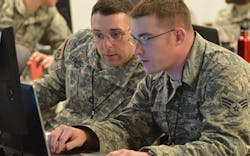Army chooses nine IT companies to provide Army computer users to desktop computers, tablets, and more
Officials of the Army Contracting Command at Rock Island Arsenal, Ill., are asking the companies to provide the Army with desktop computers; workstations; computer displays; notebook, tablet, and slate computers; thin- and ultra-thin-client computers; printers; and multi-function devices, as part of the Army Desktop and Mobile Computing-3 (ADMC-3) program.
The companies named as winners of the ADMC-3 contracts are:
-- Blue Tech Inc. in San Diego;
-- Iron Bow Technologies LLC in Chantilly, Va.;
-- Red River Computers Co. Inc. in Claremont, N.H.;
-- Intelligent Decisions Inc. in Ashburn, Va.;
-- NCS Technologies Inc. in Gainesville, Va.;
-- Dell Federal Systems LP in Round Rock, Texas;
-- Strategic Communications LLC in Louisville, Ky.;
-- GovSmart Inc. in Charlottesville, Va.; and
-- Ideal Systems Solutions Inc. in Minnetonka, Minn.
These companies will government’s worldwide requirements for commercial-off-the-shelf (COTS) IT equipment at the lowest-possible prices, and will allow the U.S. Department of Defense (DOD) to modify or develop new programs to enhance configuration management of IT and leverage buying power of IT products, Army officials say.
The contract calls for these nine companies to share $2.5 billion over the next 10 years, and make separate bids on different IT equipment orders.
The contract has a five year base period, with one five year option period. To keep pace with changes in technology, the government may issue engineering change requests (ECRs) outlining new requirements over the course of the decade-long program.
The IT equipment involved in the ADMC-3 program primarily involves desktop computers; workstations; computer displays; notebook, tablet, and slate computers; thin- and ultra-thin-client computers; printers; and multi-function devices.
Desktop computers have a main unit in a permanent location, often on a desk or on the floor. Desktop computers have an external display, keyboard, and mouse.
Integrated desktop computers have computing hardware and displays integrated into one housing, connected to AC main power mains power through one cable per computer.
Workstations are high-performance, single-user computers for graphics, design, software development, financial and scientific applications, among other compute-intensive tasks.
An electronic display has display screens and electronics encased in one housing A notebook computer, meanwhile is for portability and to be operated for extended periods of time with and without a direct connection to an AC mains power source.
A tablet computer is a notebook computer with a reversible touch-sensitive screen and a non-detachable physical keyboard. This is different from a slate computer, which relies on a touch-screen interface and input, does not have a physical keyboard, and relies on wireless communications.
A thin client is an independently powered computer connected to a computer server to obtain primary functionality. The ultra-thin client computer has fewer local resources than a standard thin client, and sends raw mouse and keyboard input to a remote computer server and receives back raw video from the remote computing resource.
Related: Contracts bring value of Army information technology (IT) program to $1.15 billion
A printer generates hard-copy output from electronic input. A multifunction device, meanwhile, performs two or more of the core functions of a printer, scanner, copier, or fax machine.
All these devices outlined in the ADMC-3 program will use the Army Golden Master securely configured operating system, and Windows-based applications like Internet Explorer, Microsoft Office Professional, Adobe Acrobat Reader, Microsoft Visio Viewer, McAfee Anti-Virus client, ActivIdentity ActivClient, Microsoft Media Player, and SUN JAVA Runtime Environment (J2SE).
On this contract, these nine companies will do the work at locations determined with each order, and should be finished by February 2027.
Learn more: search the Aerospace & Defense Buyer's Guide for companies, new products, press releases, and videos
